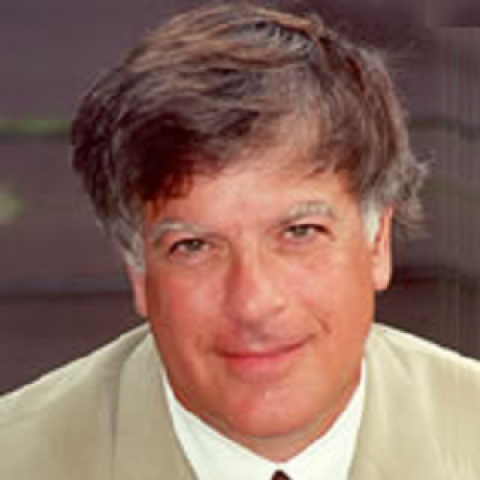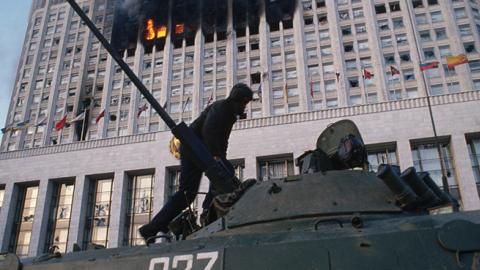Dramatically violating the constitution he swore to uphold, President Boris Yeltsin signed a decree abolishing the Russian Parliament, the Supreme Soviet, on Sept. 21, 1993. That set the stage for a two-day civil war in October, which cost at least 123 lives, and led to the rise of a dictatorship. By December a new constitution had come into force creating a super presidency and a pocket Parliament, the State Duma, which does not have the ability to contest executive power.
Yeltsin, with U.S. support, defended his actions by accusing the Supreme Soviet of sabotaging economic reform. But many Russians saw an illegal power grab, organized to return Russia to one-man rule.
The first 21 months of Yeltsin’s term were marked by heightening tension between the executive and legislative branches of government over economic “shock therapy.” In January 1992 Yeltsin abruptly freed prices. That led to hyperinflation, which wiped out the life savings of millions of Russians. He promised lower prices within a year, but by the end of December inflation was 2,318%. Many deputies expressed opposition to aspects of the reforms. Yeltsin, however, chose to ignore them. He did not explain his policies or lobby the deputies. Having been supported by two-thirds of the Parliament in November 1991, Yeltsin faced two-thirds opposition six months later.
In the summer of 1993, the Supreme Soviet recalculated Yeltsin’s budget, increasing pensions and salaries to teachers, doctors and others paid with state funds. The legislative budget provided for a deficit of 28 trillion rubles, or 25% of gross domestic product. Yeltsin vowed to ignore it on the grounds that it would wreck his reform.
On Sept. 21, Yeltsin announced he was abolishing Parliament. The deputies voted to impeach him and replace him with Vice President Alexander Rutskoi. Hundreds of deputies refused to leave the Parliament building, known as the White House. Yeltsin cut off electricity, heat and water and surrounded the building with riot police and barbed wire.
On Oct. 3, members of a fascist militia tried to force their way into the Ostankino television tower. Heavily armed internal troops then opened fire on thousands of pro-Parliament demonstrators in the adjacent square, killing 46 and injuring 124.
Yeltsin then ordered tanks to shell the Parliament on Oct. 4. The explosions created shock waves that tore the heads off victims. Many in the building—including deputies, journalists and employees—took cover in the hall of the Council of Nationalities, which was designed as a bomb shelter. Finally, with resistance having all but ceased, members of an antiterrorist unit entered the building and accepted the deputies’ surrender.
Yeltsin said the Ostankino attack forced him to shell the White House. But evidence soon emerged that Yeltsin had prepared for violence even before issuing the Sept. 21 decree, and the events at Ostankino were a preplanned massacre by the presidential side. On Aug. 3, Yeltsin promised a “hot autumn” and began visiting the bases of critical army units in the Moscow region. He also raised the salaries of officers two to three times. On Sept. 22, the day after the decree was issued, Moscow clinics were told to prepare beds for possible victims. By Sept. 29, there were 2,500 riot police around the White House, beating pro-Parliament demonstrators indiscriminately.
On Oct. 3, however, the police in Moscow mysteriously disappeared. Officers abandoned one checkpoint after another, leaving behind trucks and buses with keys in the ignition. The demonstrators drove or marched unhindered to Ostankino, where they hoped to gain access to airwaves that had been dominated by pro-Yeltsin propaganda.
Gen. Albert Makashov, leader of the parliamentarians’ White House defense, arrived at Ostankino with a group of followers, including 20 people with automatic weapons and a grenade launcher taken from the riot police. Inside the building were 500 policemen and military armed with 320 automatic weapons waiting for them behind concrete fortifications.
One of Gen. Makashov’s men fired the grenade launcher at the door. An unrelated explosion on the building’s first floor killed Nikolai Sitnikov, one of the interior forces. A solid sheet of fire from inside the building immediately raked the unarmed protestors, onlookers and journalists in the square, which was quickly littered with wounded and dead. Terry Michael Duncan, an American lawyer who had already pulled three people to safety, was fatally shot in the head.
Parliament’s supporters did not return fire. Nonetheless, Russian television announced that Ostankino had been seized by an armed mob. Yeltsin made an appeal to “the citizens of Russia,” in which he said what was taking place was “an armed mutiny that was planned in advance.”
An investigation into the October events by the general prosecutor determined that the deaths of Sitnikov and of Sergei Krasilnikov, a video editor in Ostankino, were not the responsibility of the pro-Parliament forces. Sitnikov died from an explosion inside the building. The shot that killed Krasilnikov was fired in a corridor full of Interior Ministry troops.
Leonid Proshkin, head of the investigation, said, “What happened at Ostankino cannot be described as anything but a massacre. Why was it not possible to disperse the crowd? Why did they fire on simple onlookers?”
Yeltsin’s “victory” was greeted with enthusiasm by Secretary of State Warren Christopher, who said that the U.S. does not usually support the suspension of parliaments “but these are extraordinary times.”
The illegal destruction of the Supreme Soviet and the subsequent creation of a super presidency destroyed any possibility of a genuine separation of powers. A year later, Yeltsin launched the first Chechen war. Russian liberals who had supported him found that without a real parliament, Yeltsin could unilaterally commit the army to a war against Russian citizens on Russian territory.
The 1999 Russian apartment bombings that brought Vladimir Putin to power were years in the future, as was Mr. Putin’s elimination of the remnants of democracy. But Russia’s fate was sealed in October 1993. Once Yeltsin decided to use force against elected deputies and the U.S. supported him, the emergence of a new Russian dictatorship dedicated to aggression and terror was a matter of time.


















